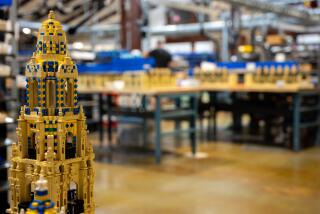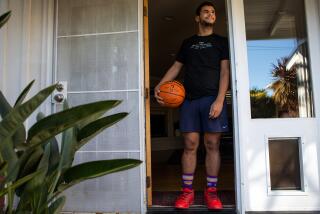Inspiring Kids? It’s Down to a Science
- Share via
BEDFORD, N.H. — A winding private drive lifts us toward Dean Kamen’s palatial New England playhouse, but I drift back to a cornstalk-straight road in the Deep South.
My wife, three kids and I are traveling around the country this summer looking at the state of the American family.
A few weeks back, we were poking around rural Georgia. We had loaded our rented RV with Vidalia onions purchased at a family farm and fat peaches we picked in an orchard that offered sufficient cover for us to pitch a few gooey ones at each other. As we continued on, dipping chips into peach and onion salsa, we passed an old woman on an old porch and three boys in the yard. We decided to turn around and talk.
Before long, two of my kids and I were charging around a dirt basketball court, heaving shots at a lopsided hoop in sweaty battle with the home team, 9-year-olds Jerry and Marcel, and Antoine, 14, who live in two trailers beside their grandmother’s house.
When the game was over, I snooped around a bit in these energetic boys’ dreams.
“I’m gonna play in the NBA,” said one.
“Me, too,” said the others.
They had no backup vision. It was basketball or nothing.
I think about those boys as we first catch sight of Kamen’s sprawling hilltop mansion. I wish they could be with us as the inventor and entrepreneur leads us through his towering front doors, then gives a mighty heave to the 20-foot flywheel on the 1847 steam engine he has built into his home’s entry.
Those Georgia kids said they’re good students.
Kamen, 45, wasn’t particularly.
But when he was 20, he invented the first portable drug-infusion pump. Then he invented one to deliver insulin.
More than 40 patents later, he’s a rich and respected engineer and physicist. He owns two corporations and a small island off the Connecticut coast. And he has a plan that he thinks can lift America’s children from the hoop dreams that have ensnared them.
To get to that, though, it’s best to stick with the tour.
With the flywheel still spinning, Kamen leads us to an intricate cage elevator that appeared in the film “The Sting.” It reminds him, he says, of Willy Wonka’s chocolate factory.
“That’s it!” I tell myself.
Kamen walks us past polished engines and machines that move like kinetic sculpture, past a giant chess set and a glass Ping-Pong table. My kids gawk and virtually quiver--as if wild man Willy Wonka were taking them through his wondrous chocolate factory.
Kamen’s enthusiasm is contagious, and soon I catch myself yelping: “Show ‘em your machine shop!”
*
Kamen designed this sprawling new home to suit his needs--one of which is the need to make stuff whenever the spirit moves him. So there, integrated into the home’s elegant, multitiered living space, is a fully equipped machine shop--one of three shops on the premises. This refusal to bifurcate work and play, life and livelihood is what impressed me about Kamen, whom I first encountered on a snowy night while tracking a candidate through New Hampshire’s presidential primaries.
Now Kamen turns to Robert, his eyes flashing with enough mischief to match our 7-year-old’s. “The only real advantage to having your own house,” he says, “is you can jump all over the couch with your shoes on and your mother can’t say anything to you.”
Leading us into the library, he swings back a portrait of Albert Einstein, giving the kids a glimpse of a hidden safe. “You know the game Clue?” he asks conspiratorially. “Shouldn’t every library have a secret passage?” Heads bob. He pushes a button and a bookcase swings open, revealing a polished wood staircase that spirals off to unrevealed mysteries.
Next we follow Kamen into an attached room with a 20-by-40-foot glass wall. Staring at this helicopter hangar cinches the kids’ long-standing contention that all that time they spent with Lego might lead somewhere.
Heat conservation is critical in winter, Kamen says. As Robert watches, slack-jawed, Kamen pushes a button and a special servomotor lifts the enormous door. Pointing to the sled-mounted copter, Kamen says that another button would push the vehicle--which he often pilots to work--onto the launch pad and the door would close, all in less than a minute.
Our final stop is a combination boardroom-dining room, whose high windows offer views of rolling forest punctuated with white church steeples.
Kamen, though, points our attention to his private baseball field and tennis and basketball courts, “just so no one gets the idea that I don’t like sports,” he says--which might be an easy mistake to make after hearing Kamen’s spiel.
What bothers Kamen, you see, is that America’s kids are scholars of sports and entertainment, but they don’t know a thing about the scientists and engineers who tinker this world together.
Kamen first confronted this odd fact more than a decade ago, while touring a New Hampshire school. He couldn’t find a single student who could name a living engineer or scientist--or even the dead ones Kamen worshiped as a boy: Sir Isaac Newton, say.
Kamen heard the standard buzz--that such ignorance was tied to inadequate resources. He dismissed it as bunk.
“It’s really hard to believe that there’s a kid anywhere who doesn’t have access to a book and a nice corner to sit and read,” he said. “All this talk about opportunity? Bag it. If kids showed up at school as eager to learn as they are to get on the varsity basketball team, there wouldn’t be a problem.”
*
Since the supply of ripping good science information is obviously plentiful, the problem has got to be low demand, Kamen figured. And because it’s far easier to create demand in America than to turn around the education system--witness the “Pocahontas” obsession a couple summers ago--he left the school thinking: “This is good news!”
Kamen had already started a children’s science center. But that sort of effort mainly draws yuppie parents--it “gives advantages to the advantaged.”
So he took the lead in creating wholesale demand for science.
Companies, he saw, seemed eager to shovel funds into the Olympics, even as they whine about how hard it is to find technologically skilled workers. So he started buttonholing business leaders, asking: “When will you use your clout to get something you want. . . . Let’s do for smarts what you guys have done for sports.”
Inspired by a contest at the Massachusetts Institute of Technology, Kamen came up with a program he named U.S. First. It has grown into an annual event in which high school students nationwide team with engineers supplied by major corporations.
Using all the equipment and brainpower available, the teams have six weeks to build robots from standardized kits containing motors, gears and remote control devices. Then the teams and their contraptions compete in a sporting-type event, which, like the kits’ components, changes every year.
“Everything about school is made to pummel you out of academic pursuits,” Kamen says. The way to infuse enthusiasm, he tells people--tells us--is to let kids work with the best engineers and scientists in the field, give them access to state-of-the-art technology, create as much recognition as they’d get playing football.
“This is real engineering,” Kamen says, pacing the kitchen floor. And the players relish that, he adds. Fired up by the challenge, the engineers often wind up working round the clock, and the participating schools often make a bigger deal of their First teams than of the ones grabbing rebounds or throwing passes.
Seven thousand high school students, 1,500 corporate and academic advisors, and almost 1,000 schoolteachers and administrators participated in this year’s competition. Texas had 14 teams; Michigan, 19. The finals, at Epcot Center in Florida, were such a big deal, Kamen says, that Disney is building a new First center for next year’s competition--and making a feature movie about the project.
One thing that’s driving Kamen nuts is that California has yet to hold a regional competition. The corporate support just isn’t there--which strikes Kamen as odd since the state that is always bragging about its high technology and lamenting its students’ dreadfully low math scores.
Kamen, whose own company hires only the best and brightest, doesn’t kid himself about how all the enthusiasm generated by First will be channeled. “Not all the students will go to Harvard or MIT. They might not be electrical engineers. But maybe they’ll go to college. Maybe they’ll work in electronics.”
That’s not the NBA. But after listening to Kamen, it’s impossible to doubt that such a career path would be at least as rewarding--and maybe more fun.
More to Read
The biggest entertainment stories
Get our big stories about Hollywood, film, television, music, arts, culture and more right in your inbox as soon as they publish.
You may occasionally receive promotional content from the Los Angeles Times.










